












In 1955, a small city in the American West made history by becoming the first in the world powered entirely by nuclear energy. Nearly 70 years later, we face a new energy crossroads that will determine whether Utah businesses have the power they need to grow, innovate, and compete.
Our state is expanding rapidly. We’re welcoming new industries, reshoring advanced manufacturing, and electrifying sectors from transportation to housing. AI and high-performance computing are adding even more pressure to the grid. But the broader challenge is one that every Utah business understands: how do we keep the lights on, keep costs predictable, and build a system resilient enough to withstand extreme weather and global shocks?
Reliable, affordable energy is not a luxury — it’s the foundation of long-term economic strength. That’s why we believe advanced nuclear energy must be part of Utah’s energy strategy.
Through our Operation Gigawatt initiative, Utah will double its energy capacity over the next 10 years. That includes wind, solar, natural gas, hydrogen, and nuclear power. We don’t believe in an “all-of-the-above” strategy. We believe in building more of what works.
Advanced nuclear energy offers a powerful combination of reliability, scalability, and efficiency. Next-generation reactors can be deployed more flexibly than legacy systems, provide consistent 24/7 power, and operate with a much smaller footprint. And they offer an opportunity to anchor an energy-intensive industry in Utah, particularly in rural areas.
In 2025, we signed a tri-state memorandum of understanding with Wyoming and Idaho to align on regional infrastructure and policy for nuclear development.

We also launched Utah’s Nuclear Consortium to bring together industry leaders, investors, and policymakers to ensure we move forward safely, strategically, and with strong public engagement.
For businesses, this means more than just grid resilience. It means price stability, the potential to attract new industrial development, and economic leadership in a sector the U.S. can no longer afford to cede to global competitors.
Yes, this is about national security, but it’s also about the day-to-day concerns of Utah companies: energy reliability, operational costs, and whether we’re laying the foundation for sustainable, long-term growth.
The American West powered the world’s first nuclear city. Now, we have a chance to power something even greater: a modern energy ecosystem built right here in Utah. We’re ready to lead, and we’re inviting Utah’s business community to build it with us.
Sincerely,

Utah’s 18th Governor
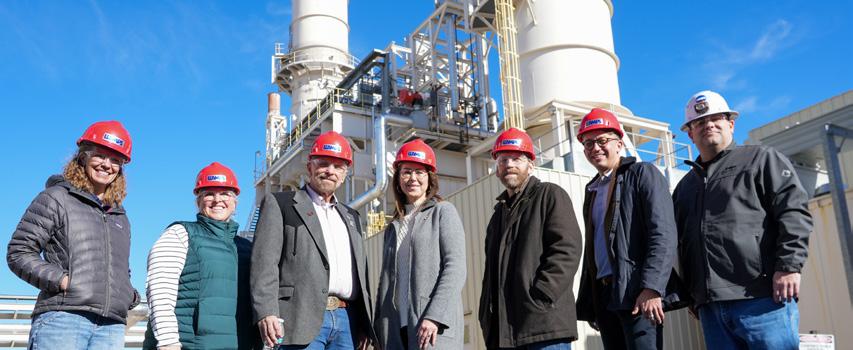
Every year, more families, entrepreneurs, and companies choose to call Utah home — and it’s no surprise to us. Our economy is thriving, our workforce is skilled, and our communities are energized. Utah is projected to grow from 3.5 million to 4 million residents by 2033, according to a study from the Kem C. Gardner Policy Institute.
As one of the fastest-growing states in the nation, this administration focuses on proactively engaging with global partners to strengthen our economy and expand the reach of Utah companies worldwide. As lieutenant governor, I’m often at the forefront of international diplomacy, developing relationships and partnerships for our state.
Over the past year, international dignitaries from more than 20 nations, including consuls general, ambassadors, trade ministers, and members of royal families, have traveled to Utah in search of investments, increased trade, and cultural exchange. In June, I led a delegation of state lawmakers and energy leaders to the United Kingdom.
The visit served two purposes: first, it furthered the UtahU.K. Memorandum of Understanding (MOU) signed in 2023, a framework for collaboration across trade, research, and diplomacy. Second, it was a nuclear energy tour focusing on exploring best practices, corporate recruitment to attract investment, create high-paying jobs, and strengthen Utah’s energy supply chain in alignment with Operation Gigawatt.
Diplomatic meetings attract foreign investments to our state and secure outside partnerships for local businesses. By building relations with other nations, we position Utah as a competitive hub for next-generation industries.
Last year, our administration signed an MOU with Austria to enhance our youth apprenticeship model, Talent Ready Apprenticeship Connection, and technical college programs. This partnership facilitates exchanging insights with a global leader in apprenticeship-based education, expanding pathways to rewarding careers for Utahns. Similarly, we
signed an MOU with Iceland following a trade mission to collaborate in industry, academia, and energy, which led to an educational exchange for geothermal workforce development and an incoming business delegation. These efforts provide essential policy insights and create investment opportunities.
Bringing in international resources is important, but it’s our collaboration with local companies that further fuels economic growth as they seek to export their products — companies like Western Zirconium in Ogden, which manufactures nuclear fuel products nationally and globally, providing skilled jobs in Weber County. A meeting with Idaho National Laboratory leadership also explored its support for Utah’s energy outcomes. An annual energy conference hosted by TerraPower here in Utah helps put the state on the map for companies looking to expand.
Through these consistent diplomatic efforts, our administration is actively bringing businesses to Utah, putting Utahns to work in skilled, high-paying jobs, and helping Utah companies expand globally. These strategic global engagements ensure Utah means business today and for generations to come.

BY: DEIDRE M. HENDERSON Lieutenant Governor of Utah

It is an honor to serve as the new executive director of the Governor’s Office of Economic Opportunity (GOEO). I’m excited to build on the strong foundation already in place.
Recently, U.S. News & World Report ranked Utah as the nation’s best economy for the 18th consecutive year and the best overall state for the third year running. These rankings reflect something even more remarkable: the people of Utah — innovators, entrepreneurs, and everyday citizens — drive our continued success with hard work and vision. We couldn’t have achieved this without you.
Beyond its unmatched economic outlook, Utah offers businesses a distinct competitive edge. With the youngest workforce in the nation — averaging 31 years old — and a highly multilingual population speaking more than 120 languages, Utah is a prime location for global companies. Over 265,000 students are currently enrolled statewide, with more than 56,000 degrees awarded annually — ensuring a strong and steady talent pipeline. With a vibrant cultural scene, top-tier educational institutions, and expanding opportunities, Utah continues attracting top talent worldwide.
As our state grows, we are committed to addressing emerging challenges while capitalizing on opportunities to fuel continued economic growth. Our strategic priorities include: supporting rural communities, preparing a highly skilled workforce, attracting companies that offer highpaying jobs, advancing Gov. Cox’s efforts to expand housing options, strengthening supply chains, and driving innovation in energy to power Utah’s future.
Utah is exceptionally well-positioned to sustain this momentum. Transformational projects like The Point and the Utah Inland Port, along with initiatives such as the San Rafael Energy Research Center, Falcon Hill, and innovation districts at multiple universities, present remarkable opportunities for growth. GOEO will play a vital role in ensuring these efforts are coordinated and aligned.
Additionally, the increasing role of higher education research and commercialization is helping drive innovation, particularly in the deep tech sector. GOEO will take a more active role in bridging these efforts with Utah’s broader innovation ecosystem.
Utah’s diverse economy is a powerful catalyst for innovation. Guided by Gov. Cox’s vision, our office focuses on key industries that showcase Utah’s strengths — including advanced manufacturing, aerospace and defense, financial services, life sciences and healthcare, software and IT, fintech, and tourism. With such broad potential, GOEO remains committed to delivering programs and services that promote economic growth and expand opportunity for all Utahns.
Entrepreneurship is the backbone of Utah’s thriving economy. Small businesses and startups comprise 99% of all Utah businesses and employ 45% of the state’s workforce.
In March, CNBC reported on a study that named Utah the No. 1 least expensive state to start a business, reinforcing our national reputation as “The Startup Capital of the World.”
As one of the nation’s fastest-growing states, Utah offers a dynamic environment where entrepreneurs can innovate, scale, and shape a thriving future.
I invite you to explore how GOEO can help you contribute to a stronger, more vibrant Utah economy. Visit business.utah.gov to discover stories about Utahns making a difference, and to learn about grant opportunities, funding programs, and business services designed to support your success.
Together, let’s continue to support, uplift, and inspire one another as we build a brighter future for Utah and our communities.

BY: JEFFERSON MOSS Executive Director, GOEO
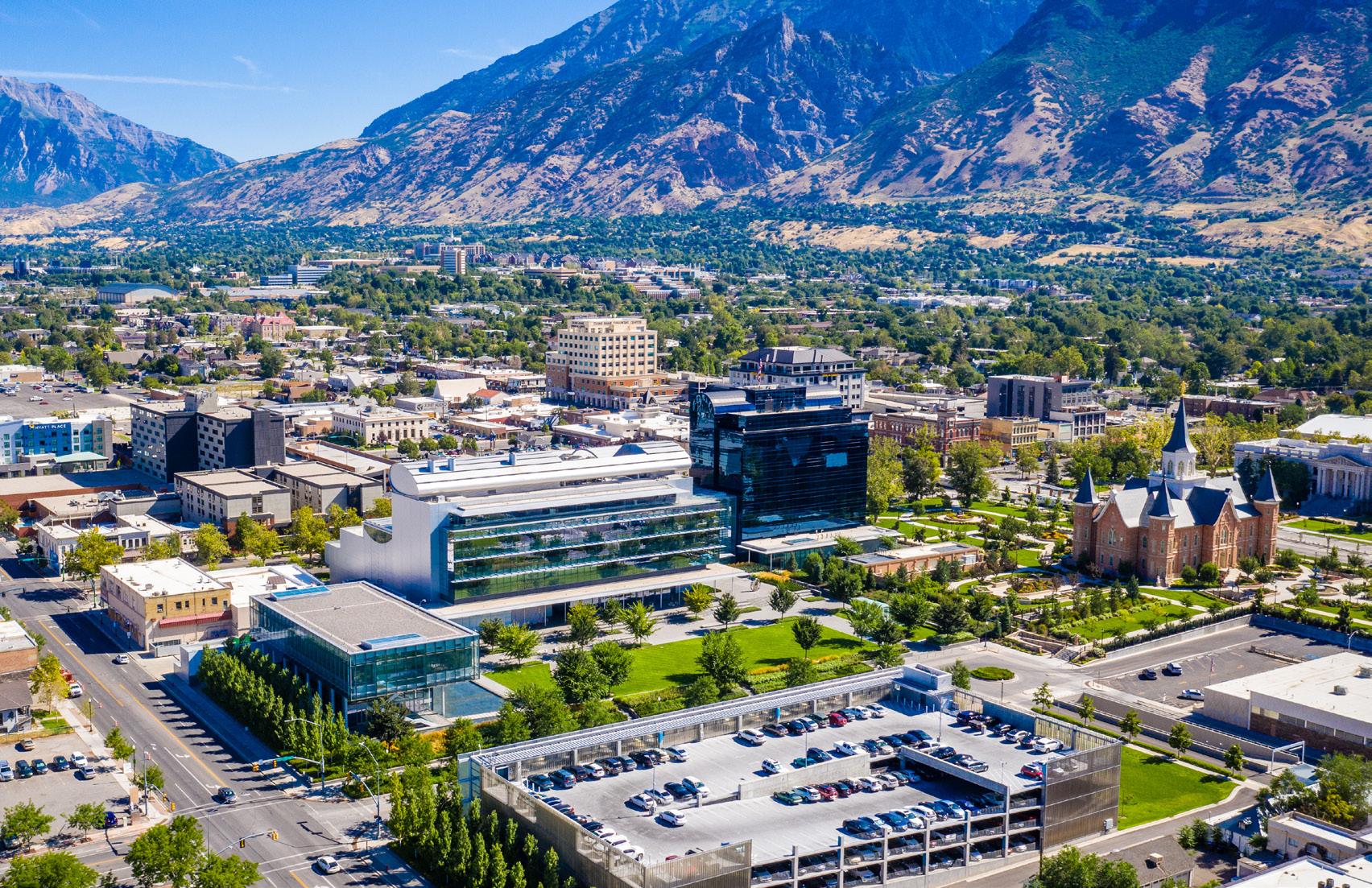
Tony serves as the director of marketing and communications at GOEO. He joined the office in 2017 as a communications specialist, working in digital marketing and events. Over the years, he transitioned to media relations manager. Tony earned a master’s degree in professional communication from Westminster University and a bachelor’s from Utah Valley University. He resides in Layton with his wife and two daughters and is passionate about flyfishing, hunting, and snowmobiling.
linkedin.com/in/tonythomasyoung
MIKE RACANELLI
Mike joined GOEO in May of 2021, serving as its creative director. He holds a Bachelor of Arts in graphic design and media management from Columbia College Chicago. A multimedia artist, Emmy® Award-winning producer, writer, musician, and published photographer, he’s spent more than 20 years working in the creative industry.
linkedin.com/in/mikeracanelli

Members of the marketing and communications team at the Governor’s Office of Economic Opportunity (GOEO) assembled the 2025 Business In Utah magazine.
Amy is the senior communications specialist at GOEO and joined the office in 2018. She earned a master’s degree in professional communication from Westminster University and a bachelor’s in mass communications from the University of Utah. Amy resides in Sugarhouse with her dog Scout, a 9-year-old golden retriever, and she enjoys hiking, baking, and going to the gym.
linkedin.com/in/amysteinbrech
Kaitlyn is the digital marketing specialist at GOEO. She joined the office as a part-time intern for the marketing and communications team in 2018 and started working full-time in May 2021. She received her associate degree from Weber State University and was certified in UX/UI website design in 2021 by the University of Utah. She resides in Farmington and enjoys spending time with family and being creative through art, music, baking, and more.
linkedin.com/in/kaitlyn-clarke
Lindsey serves as the communications manager at GOEO, where she leads media relations and supports the agency’s programs through strategic messaging, content development, and communications planning. She holds a master’s degree in global strategic communications from Florida International University, specializing in crisis management and organizational facilitation, and a bachelor’s degree in social sciences from Brigham Young University. Since beginning her career with the state of Utah in 2024, Lindsey has combined her passion for storytelling with public service. Outside of work, she enjoys reading, spending time in nature, making music, and learning from others through travel, conversation, and cultural exchange.
linkedin.com/in/lindsey-lebaron
Britany is a project coordinator at GOEO. She joined the office in July 2023 and has served in various roles with the state since 2017. Britany earned a bachelor’s degree in communications with an emphasis in organizational communication and advocacy from Brigham Young University-Idaho. She is passionate about creativity and enjoys reading, writing, and designing — usually while listening to music. Britany resides in the Salt Lake Valley and loves spending time with family, friends, and her Alaskan Klee Kai.
linkedin.com/in/britany-rich
Utah has long been known for its collective resilience. The state’s history is distinguished by communities coming together to overcome challenges, and this legacy continues to drive growth. At the intersection of tradition and innovation, the One Utah Summit brings together business, policy, and community leaders to discuss and shape the state’s future.
This year, in alignment with the “Built Here” theme outlined in Gov. Cox's State of the State address, the One Utah Summit showcases how Utah is building a prosperous future by pairing enduring traditions with groundbreaking innovations. More than a gathering for industry and state leaders, this is where community values spark new ideas and drive real progress.
From the thriving tech ecosystem in Silicon Slopes to the global logistics hub being developed by the Utah Inland Port Authority, the state creates industries that honor its legacy and advance its future. Whether it’s breakthroughs in renewable energy, innovative infrastructure, or advanced manufacturing, Utah is a leader in innovation. These advancements aren’t coming from elsewhere; they’re being “Built Here” in Utah.
The One Utah Summit is more than a showcase of new technologies and visionary ideas. The summit ensures those ideas benefit all corners of the state. There are conversations about expanding Utah’s growth, from the bustling urban hubs to its more rural areas.
One standout focus is the Utah Department of Natural Resources (DNR) and its commitment to sustainable resource management and community resilience. Through initiatives like the Watershed Restoration Initiative and the Landscape Incentive Program, DNR empowers local communities to actively participate in conservation and sustainability efforts, supporting economic growth and environmental stewardship. By investing in natural resource conservation and sustainable practices, it is helping create pathways for rural economic development, communitydriven conservation, and workforce opportunities that are resilient and focused on the future.
As Utah continues to grow, the One Utah Summit remains a crucial space for ideation and collaboration. It’s where tradition informs innovation and community drives economic progress. Each year, the summit reaffirms Utah's reputation as a place where big ideas become a reality. It’s a commitment to a thriving, community-focused future that honors the past while boldly embracing what’s next. And it all starts right here.
BY: THE ONE UTAH SUMMIT ORGANIZING COMMITTEE
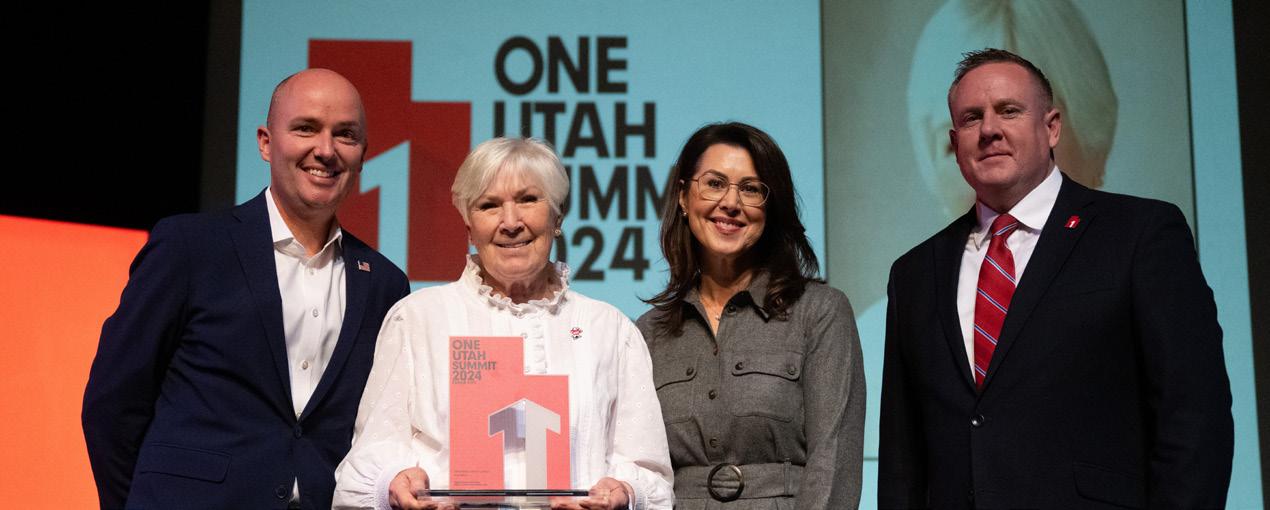



Color Country Tree Service is a tree removal and trimming company owned and operated by Dave Mineer and his son, Bryce. Based in Parowan, Utah, the company has leveraged its local expertise to serve broader needs, including wildland fire support. The company provides various tree care services, such as tree removal, trimming, pruning, and craneassisted tree removal.
Color Country Tree Service secured government contracts by registering in the federal System for Award Management (SAM.gov) and listing its resources on the U.S. Forest Service Virtual Incident Procurement (VIPR) portal.
Color Country Tree Service's journey into government contracting began in 2021 with assistance from the Cedar City APEX Accelerator office. APEX helped the company navigate the SAM.gov registration process, a crucial step for accessing the VIPR portal and submitting bids. By bidding on preseason Blanket Purchase Agreements, vendors can be mobilized for wildland fire support. Since offering initial assistance, APEX has continued to work with Dave and Bryce, providing a range of services, including SAM.gov renewals, guidance on VIPR requirements, review of solicitations, research on past awards, and support for FEMA and disaster response-related inquiries.
This consistent collaboration contributed to Color Country Tree Service's success in government contracting. The ability to secure these contracts, primarily with the U.S. Department of Agriculture (USDA) Forest Service for wildland fire suppression and related activities, provided significant financial benefits to the company, supported job retention, and created new jobs within the local community. Its commitment to delivering essential forestry support extends beyond its regional operations, demonstrating its capacity to contribute to national needs.
Color Country Tree Service exemplifies a Utah-grown business that has strategically expanded its services beyond local tree care to support national wildland fire support efforts. With the guidance of the Utah APEX Accelerator, they have successfully navigated the complexities of government contracting, demonstrating the potential for local businesses to contribute to broader needs and achieve significant economic impact within the state. To learn more about the APEX Accelerator program, visit business.utah. gov/apex.
BY: GREYSON JONES APEX Accelerator Team, GOEO

Every great business starts with an idea, and those ideas are finding fertile ground to grow in Utah. Through the efforts of the Startup State Initiative, Utah is building more than businesses — it’s creating a culture where entrepreneurship is woven into the fabric of our communities.
In April 2024, Utah launched the Startup State Initiative, a comprehensive effort to expand the state’s role as a global leader in entrepreneurship and innovation. Backed by the Governor’s Office of Economic Opportunity, the initiative builds on Utah’s consistent top-three ranking as the “Best State to Start a Business” by supporting entrepreneurs at every stage of their ventures.
This mission is reflected in the website’s robust entrepreneur journey, that illustrates the 19 steps of a startup’s life cycle. Each step is outlined with resources and guidance, from product ideation and acquiring funding to selling the business.
One of the initiative’s cornerstone programs is the "Get Started: Business Idea Challenge," developed in partnership with the Lassonde Entrepreneur Institute at the University of Utah. The program offers small grants to aspiring or earlystage entrepreneurs with ideas in any industry, providing a platform to validate and refine pitches in a supportive environment. Since launching in early 2025, Get Started has funded dozens of ideas that advance key milestones like validating concepts, building prototypes, and bringing products to market.
Get Started demonstrates that business ideas can come from anywhere, as seen in the journey of Millika Grant, founder of Consolve. When a broken fridge led to a visit from a repair technician and carbon copy paper was used to accept payment, she reflected on outdated operations and saw an opportunity for streamlined automation. This simple interaction laid the groundwork for her flourishing company.
The Startup State Initiative spotlights local companies, using real stories to inspire future Utah founders. Businesses from bakeries and boxing gyms to deep tech highlight the state’s dynamic entrepreneurial landscape. One such venture is Zia Zensations, whose founder’s story shows Utah’s draw and the benefits of doing business here.
Zia Zensations is a boutique aromatherapy brand whose origin is as unique as its offerings. Joe Zia, who co-founded the company with his wife Esther, began his entrepreneurial journey at 17 when he moved from the U.S. to Costa Rica. The couple spent nearly three decades immersed in Costa Rican life, embracing Zen philosophy, martial arts, and holistic living.
The Zias’ story took a pivotal shift in 2009 during a visit to Utah, where they fell in love with the landscape, the people, and the community's shared values. They later relocated to the state and noticed an opportunity in the local market. With a mission to support wellness, they set out to create a unique essential oil brand offering natural and custom blends, making the benefits of aromatherapy accessible to everyone.
Utah's commitment to fostering a robust startup ecosystem is evident in its rapid growth and supportive infrastructure. For 18 years, it has been named the No. 1 state with the best economic outlook, showcasing its well-educated workforce, high quality of life, access to capital, and economic resilience from Utah’s diverse range of industries.
However, the Startup State Initiative isn’t just about business — it’s about people. It empowers all Utahns by connecting them to resources and turning bold ideas into thriving ventures, proving that entrepreneurship can transform passion into a lasting impact.
For more entrepreneur resources and inspiring founder stories, visit the Startup State Initiative at startup.utah.gov.
BY: BROCK LINEBAUGH
Startup State Initiative, GOEO
Since 2022, the Utah Small Business Credit Initiative (USBCI), a program federally funded by the U.S Treasury and administered by the Governor's Office of Economic Opportunity has successfully deployed its first tranche of funding. USBCI received $69 million from the U.S. Treasury to support small businesses in the state's most remote and socioeconomically disadvantaged communities, helping them grow and expand. The program delivers this crucial funding through collaborations with Utah banks and financial institutions.
With the first tranche of $23 million fully deployed or committed by Q2 2025, USBCI has reached 16 Utah counties — 12 of them in rural areas — in collaboration with 15 local lending partners. Of the first tranche, 63.4% was deployed to Socially and Economically Disadvantaged Individual businesses, surpassing the U.S. Treasury’s 28% goal. Additionally, 41% of funding from the first tranche supported Very Small Businesses with fewer than 10 employees, vastly exceeding the federal 6% deployment target.
Funding from the first tranche primarily supported businesses in Utah, Washington, Salt Lake, Weber, Iron, Cache, and Summit counties. This investment has been instrumental in creating or retaining almost 400 jobs statewide. Individual financing ranged from $2,800 to $3 million in USBCI funds.
USBCI’s funding extends across various industries:
• 17% to lessors of residential buildings
• 16% to hotels and motels
• 12% to RV parks and campgrounds
• 9% to trucking
• 7% to education
The remaining 47% supported diverse sectors such as construction, healthcare, payroll, and beauty services. In terms of job creation, 40% were in amusement and recreation, 11% in hotels and motels, 6% in education, 4% in concrete construction, and 4% in lessors of nonresidential buildings. The remaining 34% of jobs were in scientific, beauty, landscaping, and payroll services.
USBCI secured its second tranche of $23 million in Q1 2025, ahead of its initial schedule of June 2025 (Q2). This early commitment underscores the program’s strong momentum and continued ability to support Utah’s small business community.
In Q2, USBCI also began developing two additional initiatives to further bolster the program: the Utah Chamber Referral Incentive Program and the Technical Assistance Program.
USBCI acknowledges the vital role chambers of commerce play in communities statewide, connecting businesses with essential resources. By partnering with this program, chambers assist local businesses in securing crucial funding and receive a referral incentive of up to $7,500 for their organization.
The U.S. Treasury’s Technical Assistance Program (TAP) authorized $1 million for USBCI. TAP allows USBCI to offer vital legal, accounting, and financial advisory services through private contractors to qualifying Very Small Businesses and Socially and Economically Disadvantaged Individual businesses preparing to apply for USBCI funding. Through TAP, USBCI aims to enhance operations, strengthen management, and foster entrepreneurial success for these businesses.


This year marks a significant milestone for Utah’s economic landscape, with the Governor's Office of Economic Opportunity (GOEO) celebrating its 20th year in business recruitment and expansion.
A cornerstone of this success is the Economic Development Tax Increment Financing (EDTIF) program, authorized by the Utah Legislature in 2005. The program distinguishes itself from other states by providing tax refunds after a company meets the agreed-upon performance benchmarks. This model ensures accountability and a demonstrated return on investment for Utah taxpayers. Companies operating on the Wasatch Front in GOEO's targeted industries — such as aerospace and defense — that meet criteria for new, highpaying jobs, can receive a refund of up to 30% of their new state taxes for as long as 20 years.
In recent years, the program has also evolved to include a community service requirement, emphasizing the commitment of incentivized businesses to give back to communities that support their growth. This strategic approach, employed for over 20 years, has helped Utah close highly competitive deals in high-value targeted industries.
Williams International demonstrates how collaborations between the state, community, and local businesses can ignite business development through three major expansions in Utah since EDTIF's inception.
Williams International, a leading developer and manufacturer of jet engines for military and commercial aircraft, established its Ogden facility in 1978. Its journey with the EDTIF program began early with its first expansion in 2005, aligning with its initial authorization.
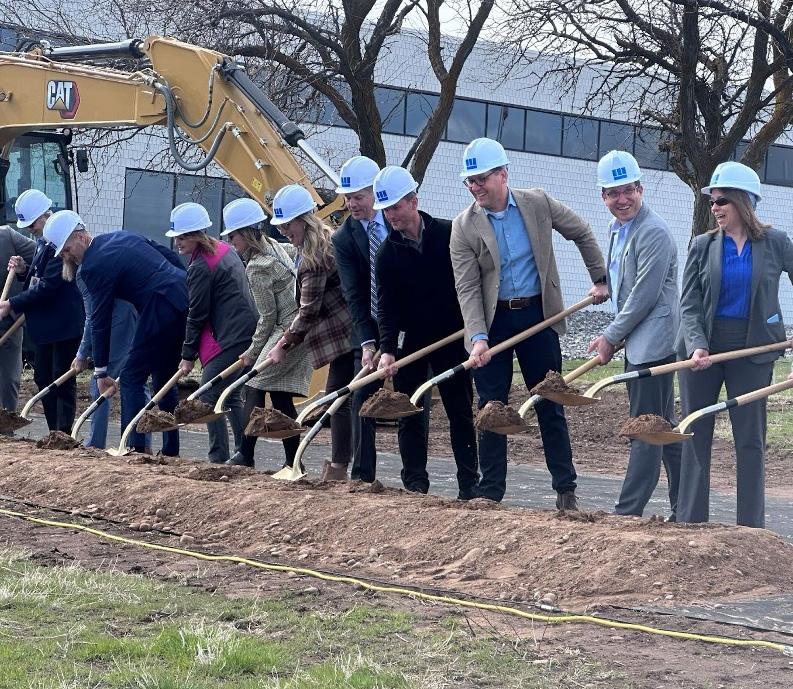
In November 2020, the company announced another significant expansion in Ogden to relocate production from a facility in Mexico impacted by a fire. The expansion aimed to add 300 jobs and represented a $60 million project. Former Ogden City Mayor Mike Caldwell expressed enthusiasm. “As one of our largest employers and a key business in our aerospace and defense industry cluster, we are excited that Williams International chose to expand its footprint in Ogden. This project will bring more quality, high-paying jobs to our community and support the city's efforts to develop Ogden Airport as a regional center for the aerospace and defense industry.”
In March 2025, Williams International unveiled its latest and perhaps most ambitious expansion, set to add over 300 high-wage aerospace jobs and an expected investment of over $1 billion in its Utah operations over the coming years. This expansion is supported by a local Tax Increment Financing incentive from the Ogden City Redevelopment Agency board. "This expansion embodies 'The Ogden Way'
of creating economic opportunity and building a community where all can thrive," Mayor Ben Nadolski said. The incentive will also fund crucial electrical infrastructure, benefiting Williams and other businesses in the area.
The scale of these investments is an example of how strategic partnerships and forward-thinking incentive programs like EDTIF can provide economic prosperity and community growth. These expansions create direct employment and stimulate growth in supporting industries, further establishing Utah as a national leader in aerospace and defense.
For additional information about business expansion and the tax incentive programs in Utah, please see business.utah.gov/recruitment.
BY: JIM GROVER Economic Growth Team, GOEO

The Governor's Office of Economic Opportunity (GOEO) agrees that Utahns, like the rest of Americans, are among the most fortunate people in history. We have continued to face challenges by refreshing our perspective and approaching opportunities with creativity, hard work, and collaboration. The community grants team takes on economic development challenges in our state and delivers opportunities.
Beyond urban cities and suburbs, GOEO partners closely with rural communities, understanding their vital role in Utah's economy. To meet the specific needs of these areas, GOEO runs the Rural Communities Opportunity Grants (RCOG) program. These grants offer direct financial support to rural cities and counties for various economic development projects. “Utah is fortunate to have tremendous economic diversity across the state,” said James Dixon, director of community grants at GOEO. “One county’s primary industry can be very different from another’s.”
The grant application process is flexible, letting communities propose solutions that fit their unique situations while concentrating on business recruitment, workforce training, and infrastructure for business development. This approach ensures resources are allocated where they'll have the biggest impact, spreading Utah's economic success across the entire state.
The team also manages other funding opportunities. Annual and ongoing offerings include the Rural County Grant, the Rural Employment Development Incentive, and the Economic Assistance Grant. It works closely with GOEO’s five regional outreach managers who represent its programs across the state. Their outreach efforts establish connections with local governments and businesses and point them not only to our grants, but also to other GOEO resources and services offered by departments such as Business Recruitment and Expansion, the Startup State Initiative, the Utah Film Commission, the Utah Office of Regulatory Relief, the Utah Office of Tourism, and the Utah Small Business Credit Initiative.
In addition to GOEO’s internal departments, the community grants team maintains close relationships with other state departments that also deliver grants and funding opportunities, such as the Governor’s Office of Planning & Budget, the Department of Agriculture and Food, the Office of Energy Development, and the Department of Natural Resources Division of Outdoor Recreation.
By supporting local governments and businesses, GOEO helps turn challenges into opportunities. Its resources and partnerships will continue to ensure Utah remains a national leader in economic growth.
For more information on GOEO’s grant opportunities, visit business.utah.gov/grants.
BY: THE COMMUNITY GRANTS TEAM, GOEO

Utah’s economy and population are growing at record speeds, creating exciting opportunities while bringing new challenges that demand innovative solutions.
The Governor’s Office of Economic Opportunity (GOEO) and the Department of Natural Resources have recently partnered to tackle one of Utah’s most pressing issues: creating energy abundance.
Our offices engaged with experts from around the world to exchange success stories in the energy industry. As a result, we’ve been to small-scale geothermal heat systems in rural Iceland, nuclear fuel facilities in the United Kingdom, and met with Canadian critical mineral mining companies.
International collaboration is not new to Utah. Since its founding, Utah has been a place where great minds from around the world come together to build the future. When religious refugees settled the state in 1847, they brought a wealth of knowledge from their home countries. Among many others, German thinkers bolstered Utah’s academic institutions and designed our capitol building, Chinese and Japanese workers built railroads, and Welsh miners supported the coal industry.
As a result of Gov. Cox’s Operation Gigawatt initiative, GOEO’s international team adopted energy diplomacy as a central pillar of its global strategy to support the state's efforts to make Utah energy efficient in the next five years. By learning best practices from international partners in both the private and public sectors, Utah is poised to kickstart its path to energy abundance with effective policy and targeted corporate recruitment.
GOEO’s first energy diplomacy trip brought Utah policymakers and economic developers to Iceland to study geothermal power production. By meeting with government leaders, industry associations, and geothermal companies, the group gained insight into regulatory frameworks and
business development strategies. The trip resulted in an Iceland-Utah Memorandum of Understanding to facilitate best practice exchange, initiate a workforce development exchange with Southern Utah University, and prompt an Icelandic geothermal business delegation to explore opportunities in Utah.
This year, GOEO’s international team focused on nuclear energy, bringing Utah’s energy experts to the United Kingdom. The delegation met with the British government officials and engaged with companies across the nuclear value chain, including companies specializing in fuel enrichment, small modular and microreactor technologies, as well as manufacturers, universities, apprenticeship programs, and engineering firms. The lessons learned abroad could power Utah’s nuclear supply chain — helping our state improve safety, protect water quality, support waste management, enhance workforce development opportunities, and strengthen community outreach.
GOEO’s energy diplomacy is essential in attracting investment that could bring high-paying, targeted industry jobs to the state and strengthen Utah’s energy supply chain. Through diplomacy, the international team connects state policy makers with global governments to learn best practices for energy regulation.
In Utah, we are building in the same way we always have — working together with global experts to create the best solutions right here in Utah.
To learn more about Utah’s international strategy, read about the team’s projects at business.utah.gov/international.
BY: THE INTERNATIONAL TRADE & DIPLOMACY TEAM, GOEO

The Center for Rural Development, housed under the Governor’s Office of Economic Opportunity (GOEO), works with Utah’s rural counties, communities, and businesses, providing economic development resources that lead to prosperity. It is the home of the Rural Opportunity Program and assists with economic development grants and incentive programs. These programs deliver over $8.3 million annually, acting as a force multiplier, accelerating projects in Utah’s 24 rural counties.
“The center’s outreach managers are at the heart of our programs. They live in and serve rural communities across the state to help local governments take advantage of the abundant economic opportunities in rural Utah,” said Colette Cox, director of the Center for Rural Development. The center’s skilled team members also guide economic development leaders and business owners through program and incentive application processes, offering expert advice in workforce, infrastructure, and business development areas.
As an example of the center’s work in 2024, GOEO's executive director and outreach managers visited the 24 rural counties to evaluate challenges and program effectiveness. The needs expressed during meetings with local elected leaders and economic development professionals have inspired multiple additions to Utah’s 2025 rural programs. One example is the Rural Economic Blueprint pilot program, which provides strategic planning for nine of the state's rural frontier communities.
The center’s foundational program is the Rural County Grant (RCG), which provides $200,000 yearly to Utah’s 24 rural counties. It empowers rural county governments to manage their unique projects and take responsibility for planning and activities leading to improved economies. The grant addresses economic development needs within the following categories:
• Business development, expansion, and recruitment
• Workforce training and development
• Infrastructure, industrial building development, and capital facilities improvements for business development
Since 2020, the RCG has infused the 24 rural counties of Utah with more than $16 million for projects that boost the local economy. One of the most important parts of the grant programs offered to rural counties is the requirement for a functioning County Economic Opportunity Advisory Board appointed by the county legislative body, representing various sectors and backgrounds. These advisory boards
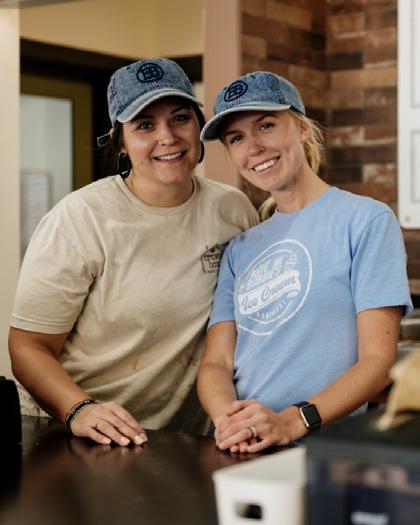

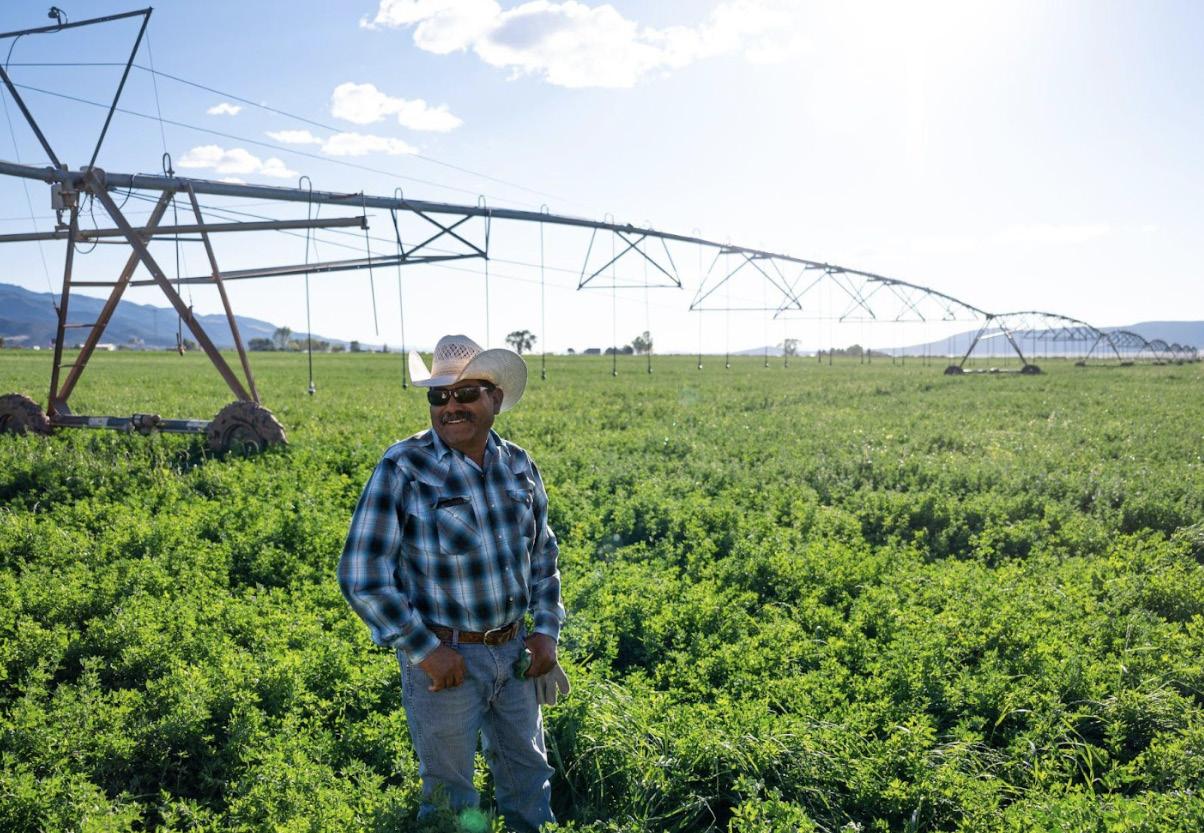
comprise at least five members who advise the legislative body on economic development matters. These boards focus on business growth and development opportunities specific to their regions.
“County Economic Opportunity Advisory Boards are key to identifying and driving good business development ideas," shared James Dixon, director of community grants. “The collaboration of these boards with their governing bodies brings economic development and business growth to the forefront of planning and opportunity in our rural counties and communities.”
One of the many examples of projects supported by the RCG is the annual San Juan County Business Basecamp Conference and Expo that catalyzes economic vitality in the region. With the support of the RCG and sponsorships, the San Juan County economic development department empowers the local community to engage directly with the challenges and opportunities of the modern rural business landscape. This event is more than just a gathering; it's a vital nexus where business owners, nonprofits, local organizations, government agencies, and community leaders from San Juan County, the Four Corners region, the Ute Mountain Ute Tribe, and the Navajo Nation converge. Participants gain access to crucial networking opportunities and practical workshops that address real-world problems with proven best practices.
The RCG program is one of GOEO’s greatest tools, driving economic growth. Last year, over $1.8 million of funds were distributed throughout 13 of the 24 rural Utah counties as subgrants for various economic development projects and small business support. These projects included workforce development, business construction, equipment upgrades, and investments in new industries. Specific grant programs included signage improvement, facade and tenant improvement, and small business support. Subgrants also supported local lodging to increase occupancy, enabling businesses to hire additional staff and extend operating hours.
“The collaboration between GOEO and rural Utah fosters a dynamic environment where innovative solutions are born, leading to stronger, more resilient businesses and a more prosperous local economy,” said Colette Cox.
To find a summary of grants and incentive programs and local contact information, please visit business.utah.gov/rural.

Imagine a Utah where small businesses have the workforce they need to thrive and individuals who have legally immigrated find meaningful careers that allow them to build prosperous lives. This vision is at the heart of the Utah Center for Global Talent’s mission.
In today’s dynamic economy, securing the talent required for growth and innovation is a persistent challenge for Utah’s businesses, particularly for vital small enterprises. Simultaneously, many skilled professionals arrive in Utah through legal immigration pathways, eager to contribute their expertise but often face hurdles in navigating credentialing and employment systems. The Utah Center for Global Talent is a crucial bridge connecting these two critical needs.
Established by the Utah Legislature, the center recognizes the immense potential within our global community. It’s focused on creating pathways for foreign-born, legally documented individuals to integrate into Utah’s workforce, providing much-needed support to local businesses. The team’s work is rooted in the understanding that legal immigration is not just a humanitarian imperative but also a powerful economic driver.
The center addresses workforce shortages that can stifle growth by helping companies legally employ foreigncredentialed workers. This allows Utah’s small businesses to access a broader pool of qualified candidates, encouraging innovation and ensuring continued competitiveness.
Equally important is the center’s commitment to providing economic opportunity for legal immigrants. Individuals who follow the legal processes to make Utah their home bring diverse skills and experiences. By assisting them in navigating the complexities of the U.S. job market, recognizing their international credentials, and connecting qualified individuals with suitable employment, the center empowers workers to support their families and build a stable future in Utah.
Ultimately, the Utah Center for Global Talent fosters a win-win scenario. Utah’s small businesses gain access to the skilled workforce they desperately need, fueling economic growth and creating local jobs. Simultaneously, legal immigrants find opportunities to utilize their talents, provide for their families, and contribute to the vibrancy of our communities. By focusing on these mutually beneficial outcomes, the center strengthens the state’s economy and enriches the lives of all Utahns.
BY: THE UTAH CENTER FOR GLOBAL TALENT, GOEO

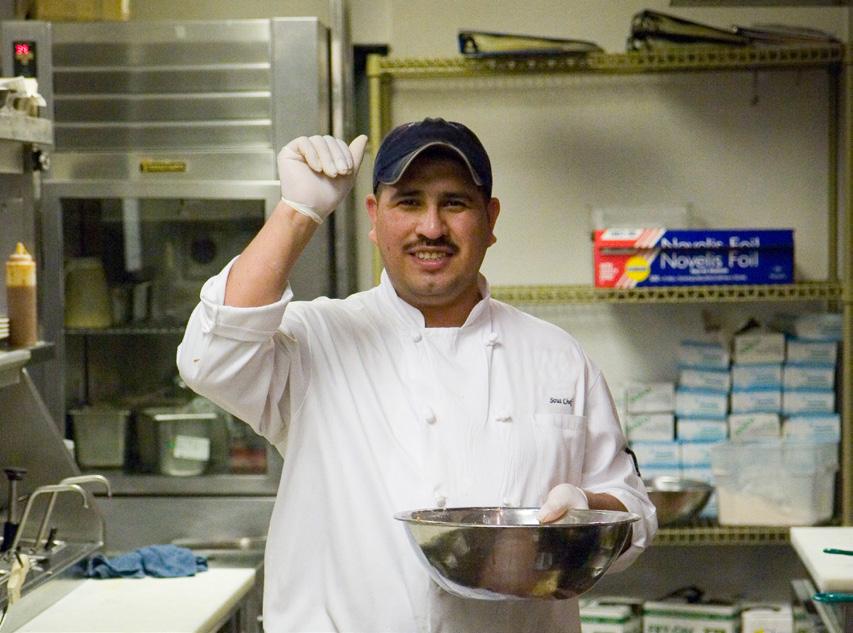


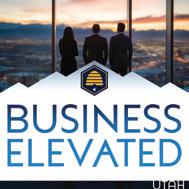

When most people think of regulatory sandboxes, they imagine startups testing new financial technologies or companies piloting innovative healthcare models. However, these flexible regulatory environments, designed to temporarily lift or modify rules that may hinder innovation, are not limited to the business sector. Regulatory sandboxes can be powerful tools for nonprofit organizations seeking to solve complex social problems in novel ways.
As Utah leads the nation with its cross-sector sandbox model, it's important to spotlight how nonprofit organizations, not just for-profit businesses, stand to benefit and have already done so in other states.
A regulatory sandbox provides a structured space for entities to test new products, services, or delivery models without being immediately subject to regulations that might otherwise apply. Regulatory sandboxes allow innovation to flourish with oversight and by updating or rethinking outdated rules. In Utah, the sandbox is open to businesses, nonprofits, and government agencies.
Nonprofits are often constrained by the same regulations as businesses, but have far fewer resources to navigate complex compliance landscapes. A sandbox gives them a chance to experiment with:
• Innovative service delivery models
• New funding mechanisms (like social impact bonds)
• Partnerships with private-sector entities
• Technology-driven interventions
For nonprofits serving marginalized communities or operating in highly regulated areas like healthcare, education, or housing, sandboxes can foster creativity without compromising accountability.
EXAMPLES OF NONPROFITS BENEFITING FROM SANDBOXES
Several sandboxes across the country have already welcomed nonprofit organizations:
While primarily aimed at financial technology firms, Arizona’s sandbox allowed Catholic Charities Community Services to participate in a pilot that helped refugees establish credit through alternative underwriting models. This effort provided financial inclusion tools typically out of reach for the populations they serve.
This sandbox allowed nonprofits to explore blockchain and digital payment solutions. Some participants worked on transparent donation tracking systems using blockchain, ensuring donors knew exactly where their funds were going.
A nonprofit health cooperative was given space to test community-funded insurance pools in rural areas, experimenting with models that traditional regulations would have blocked.
Utah’s sandbox, governed by the Office of Regulatory Relief (ORR), fosters inclusion. Unlike most states, Utah's program opens the door for nonprofits and public sector agencies to participate. This has the potential to:
• Boost cross-sector innovation
• Level the playing field for under-resourced innovators
• Address public challenges in novel ways
By welcoming nonprofits into the sandbox, Utah recognizes that innovation isn’t exclusive to the marketplace. It also thrives in the social sector, where new approaches can mean better outcomes for real people.
Utah-based nonprofits developing innovative approaches to healthcare delivery, affordable housing access, education equity, or beyond can apply to the sandbox to test their ideas without facing immediate regulatory burdens. If successful, these pilots can pave the way for permanent rule changes supporting long-term impact.
The process is straightforward, and the ORR works closely with applicants to help refine their proposals and liaise with relevant regulatory bodies.
We encourage nonprofits across Utah to think big. The sandbox is more than a policy tool; it’s a platform for testing bold ideas that serve the public good. Whether you're using data to predict homelessness, trying a new eldercare model, or exploring a hybrid funding strategy, Utah’s sandbox may be the space you need to launch something transformative.
Innovation shouldn’t be gated by bureaucracy, and with Utah’s inclusive sandbox, it doesn’t have to be.
For additional information, visit our website at business.utah.gov/regulatory-relief.
BY: MCKAYLA CARESS
The Office of Regulatory Relief, GOEO
Utah’s breathtaking landscapes, world-class recreation, and vibrant urban destinations attract visitors from around the world. When these visitors plan their Utah adventure — booking a hotel, hiring a guide, shopping locally, and dining at a restaurant — they invest in our state's future.
That’s why we love welcoming visitors — to experience firsthand why life is better in Utah. Whether attending sporting events, visiting galleries, or dining and shopping locally, visitors play a crucial role in our state’s economy. These contributions benefit Utahns for generations to come — we call this the visitor economy.
One of tourism's most significant impacts is the direct financial contribution visitors make to our state. According to the Kem C. Gardner Policy Institute, in 2024, visitors spent a record $13.3 billion in Utah, supporting 164,600 travel-related jobs and generating $2.5 billion in state and local tax revenue.
In 2024, economic investments generated by visitors supported 102 outdoor recreation projects across 24 of Utah’s 29 counties. Through transient room taxes, sales taxes, and other visitor-generated revenue, Utahns enjoy improved trails, expanded public lands access, and upgraded recreational facilities.
A great example is the ongoing development of Western Sports Park in Davis County. This $70 million project, funded solely by tourism taxes, will be a premier destination for events and youth sports, enhancing community resources and allowing visitors to support local businesses.
The Bryce Canyon Mule Days is another example of a recreational event started by locals. This event showcases the area’s unique character, gives back to the community, and supports the local economy during the shoulder season. Annual funds raised continue to support local families battling cancer.
Beyond the major metropolitan areas, tourism is a lifeline for many of Utah's rural communities. Gateway communities to our national parks and recreational areas rely heavily on visitor spending to sustain local businesses and services.
Businesses — many of them family-owned for generations — thrive because of visitors. Take, for instance, the multigenerational businesses in the town of Tropic, like The Pizza Place and Bryce Canyon Inn. Longevity isn’t just about great food or a comfortable stay — it’s closely tied to visitation.
Even in quieter rural areas, tourism supports families and communities with deep roots in the area. The Roundy family, who returned to Garfield County to establish Escalante Yurts, are among those who have established unique lodgings that attract a higher-spending clientele. This has sparked a "ripple effect," leading to improvements in local infrastructure, including better roads and the installation of electric car chargers. In many rural locations, visitor funds have supported well-equipped emergency services, search and rescue units, solid waste management, and county backroads.
Utah is at the forefront of cultivating, strengthening and, most importantly, diversifying the tourism economy. A prime example of this diversification is agritourism. In partnership with the Utah Department of Agriculture and Food, as well as the Utah Farm Bureau Federation, Utah’s tourism industry actively supports the growth of this crucial sector. This allows visitors to engage with agricultural entertainment, recreation, or education through animal encounters, corn mazes, farm-to-table events, farmers markets, and more. This diversifies income for farmers and ranchers and provides visitors with invaluable first-hand experiences.
Tourism in Utah is more than an industry — it's a commitment to economic well-being, community vitality, and the enduring legacy of our extraordinary state.
BY: THE UTAH OFFICE OF TOURISM & FILM, GOEO



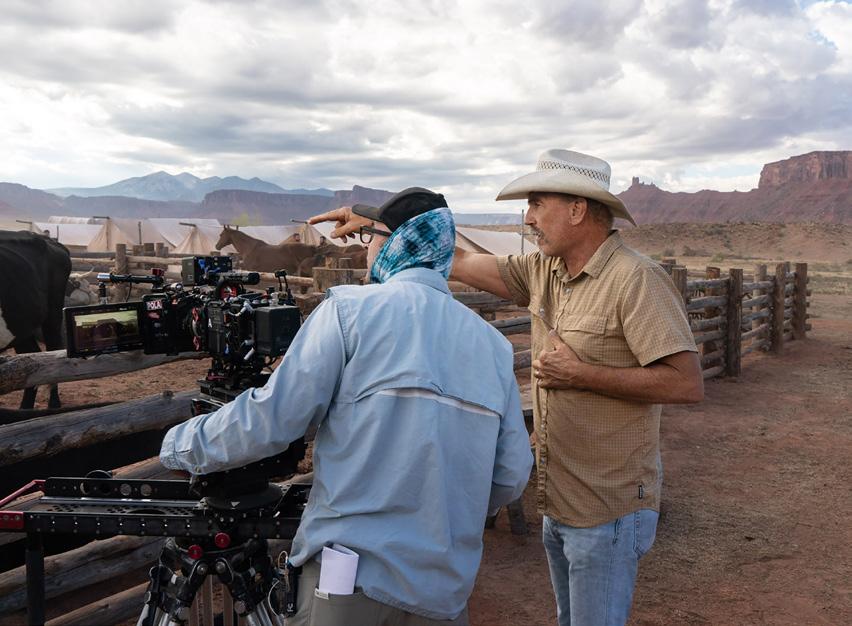
On the set of Horizon: An American Saga - Chapter 1 with Director Kevin Costner / Credit: Richard Foreman/ Warner Bros. Pictures, ©2024 Warner Bros. Ent. All Rights Reserved.
Utah's unique landscape has always inspired great storytelling. Tales and legends are etched into the walls of the state's red canyons, the journals of its early explorers, and the hearts of locals and travelers. It's no surprise that Hollywood is repeatedly drawn to Utah's landscapes and locations. For over 100 years, the state has been America’s Film Set, but it has provided more than just backdrops. It has supplied artisans, actors, and auteurs, launching careers and creating other financial opportunities here in the Beehive State.
Most recently, academy award-winning actor and director Kevin Costner selected Utah as the setting for his epic western, “Horizon: An American Saga,” shooting two featurelength films between 2022 and 2023 with the support of the Utah Film Commission’s Motion Picture Incentive Program. Shot across five counties in rural Utah over 200 days, these productions left a direct and lasting impact on Utah’s economy, with spending exceeding $95 million.
Hollywood and independent filmmakers have long been drawn to this small, otherworldly place. From Monument Valley to The Mighty Five®, snow-capped summits to deep cracks, a Golden Spike to an Olympic Torch (or two), moving pictures have captured them all. But, regardless of budget, as these chroniclers cross the Virgin, Green, or Colorado rivers, they discover something more — a creative culture teaming to provide them with the insight, expertise, and infrastructure necessary to bring their visions to large, small, and even handheld screens.
This culture is more than “Utah Nice”; it embodies sound business practices among local individuals and communities. Indeed, while A-listers may leave the glitz and glam on Rodeo Drive for a bit of grit in Grand County, they bring significant financial resources to local restaurants, caterers, store owners, animal handlers, drivers, cleaners, landowners, including Willie Jessop in Apple Valley, and hoteliers, such as Cave Lakes Canyon Ranch in Kane County.


Jessop, whose Peacemaker Ranch was one of the principal settings for “Horizon: An American Saga,” watched with wonder as Costner and hundreds of crew members, including numerous Utah actors and technicians, filed into his working ranch, bringing massive amounts of equipment and even more livestock, transforming the place he’d lived for decades and leaving it better than they found it. The experience was positive for Jessop personally and financially.
“There was a great sense of pride as to what Southern Utah really was, and to be able to see, all of a sudden, those mountains on a big screen. It’s just jaw-dropping. It was always here, but Hollywood really did show us what we have.”
— Willie Jessop, Rancher, The Peacemaker Ranch. Credit: PBS film, “Hollywood in Utah” (2024)
The Utah Film Commission, part of GOEO, fosters and highlights the fiscal and long-term benefits of film production in the state. The state receives a $7 return for every $1 invested. From tax rebates to tailored incentives, the commission’s efforts have a multiplier effect, resulting in more jobs and funds for those communities, especially in rural Utah counties where filmmakers can receive even greater benefits.
From ancient canyon walls to IMAX and iPhone screens, Utah has been a home for storytellers, making it America’s Film Set. Today, its communities and people welcome filmmakers, providing resources and expertise to bring their visions to audiences worldwide and receiving measurable benefits here in kind.
BY: PAULA COLMAN
UPSTART is a state-funded, free-of-charge, at-home early education program that prepares children for kindergarten before they enter a classroom. What started as a pilot program in Utah 16 years ago has grown into a successful statewide initiative, helping thousands of young learners get a strong academic start.
This program is administered by the Utah Governor’s Office of Economic Opportunity (GOEO) and operated by Waterford. Also known as Waterford UPSTART, the program ensures a strong future and helps build a skilled, resilient workforce in the state.
The Utah Legislature has continued to fund Waterford UPSTART to provide an effective academic foundation in a state where access to brick-and-mortar isn’t always feasible.
• More than 126,000 children have participated in Waterford UPSTART since 2018
• 16,234 children were enrolled in 2024-2025
• 15,136 students are using the at-home-only model
• 9,548 children are not attending any other pre-K program
• 8,844 live in rural areas, where preschool options are often limited
• 5,138 families live below the federal poverty level (about one-third of participants)
• 1,370 families speak a primary language other than English at home
Children participating in Waterford UPSTART spend about 15 minutes daily, five days a week, using an online platform that teaches early reading, basic math, and science. The lessons feel like games, songs, and stories, keeping young minds engaged while building core skills.
The program uses adaptive technology, which adjusts to each child's learning level and helps them grow at their own pace. Parents also receive tools and coaching to help support learning at home. Waterford provides both at no cost if a family cannot afford a computer or internet connection.
Children who complete the UPSTART program tend to start kindergarten with stronger literacy skills and greater confidence in learning. These early advantages often carry through elementary school, especially in reading and language arts.
UPSTART provides a flexible and effective solution for parents who may not have access to local preschool programs or prefer an at-home option. It is especially valuable in rural areas of the state for these reasons.
One mother from rural Utah said, “My son started the program barely recognizing letters. By the end, he was reading simple books and couldn’t wait for kindergarten.”
Waterford UPSTART is available for children the year before they enter kindergarten. It began in Utah and has expanded to several other states through grants and government support. In Utah, it remains free to families statewide.
To learn more about the program, tune in to a recent episode from the Business Elevated podcast hosted by GOEO. The podcast episode, “Building Foundational Skills Through Early Education with Waterford UPSTART,” offers insights and discussions highlighting the program’s impact and success.
Enrolling is easy. Families can visit waterfordupstart.org to fill out a short registration form or call 888-982-9898 for more information.
BY: THE UPSTART TEAM, GOEO


From the rugged red-rock deserts to majestic snow-capped mountains, Utah’s diverse and striking landscapes are matched only by its people and industry. This is where pioneers forged the first major settlement of the American West, where the Golden Spike united the free world, and where the first successful artificial heart transplant was performed. These weren’t just pinnacle achievements for the state; they dramatically shifted America’s influence on the world stage. Today, we stand at another crossroads, and Utah is again at the helm.
Turning challenges into opportunities is part of the state’s unique identity; we lead through imagination and achievement, and now, we’re focused on energy. Surging demand for electricity — driven by artificial intelligence, electrification, and advanced manufacturing — is reshaping how we live, work, and play. Manufacturing, heavy industry, data centers, farms, homes, and schools depend on abundant, reliable, and affordable energy. Without that energy, we risk losing opportunities or compromising national security. With it, we unlock prosperity, energy independence, and innovation. Without it, we risk stagnation. Few are ready to tackle the energy challenges that have emerged. Even with Utah’s best-in-nation economy, readiness for uncertainty, and pioneering heritage, we’re facing the technology and energy revolution with a solid plan and commitment to creating energy abundance.
Operation Gigawatt is our 10-year plan to create energy abundance. We’re doing this not because we can but because the moment demands it. Energy, economic growth,
and national security have never been more interdependent than they are today, especially as artificial intelligence makes its way into global economies. Experts across these fields agree that we need more energy and innovation to secure America’s future on the global stage, and Utah stands ready to lead the way.
Operation Gigawatt is more than an energy initiative; it's a playbook that supports Gov. Cox's “Built Here” plan. The goals of Operation Gigawatt are ambitious, but Utah can deliver. We are modernizing transmission, diversifying generation, enabling innovation, and leading through research at the Utah San Rafael Energy Research Center.
We are investing in nuclear innovation and a statewide nuclear consortium to drive industry, academia, and community collaboration. We’re allocating funding to map Utah’s vast geothermal potential and securing partnerships at the Utah San Rafael Energy Research Center to test and scale cutting-edge nuclear technologies. The Utah Advanced Nuclear and Energy Institute, a partnership with the Utah Office of Energy Development, and one of the country’s premier research labs, Idaho National Laboratory, will foster collaborations across the state’s public and private universities and colleges, bringing together our thought leaders and researchers to accelerate next-generation energy technologies and workforce programs. By partnering with utility companies, local leaders, and state and federal agencies, we’re protecting Utah's energy supply against cyber and natural threats, streamlining regulations to support rural communities and families across Utah, and fostering job-creating innovations.
At its core, energy is a fundamental issue of prosperity. Operation Gigawatt is our commitment to building and securing abundance for Utahns today and for future generations. Energy abundance has become critical to economic stability, national security, and innovation. Operation Gigawatt isn’t just about megawatts; it’s about building and maintaining America's momentum to lead the world in the coming technological revolution. Building a prosperous society, continually ranked as the number one state for quality of life, took grit and vision. And that same grit and vision propels Utah rapidly toward an energy-abundant future, because the future won't wait.
BY: THE UTAH OFFICE OF ENERGY DEVELOPMENT
Utah isn’t waiting for the future to happen; we’re building it here.


What Utah products come to mind when we say, “Built Here”? You might be surprised how many world-class goods are produced right in our backyard.
"Built Here" doesn’t just describe where Utah products begin — it reflects the mindset of the people building what’s next. From aerospace innovations to wellness and outdoor gear, Utah’s manufacturers and entrepreneurs are proving that what starts here can compete and thrive anywhere.
Autoliv’s Brigham City plant is the world’s largest airbag inflator facility. Hexcel is the world’s largest producer of highperformance carbon fiber, used in nearly every Boeing and Airbus aircraft. Utah also supplies 70% of the world’s arterial and vascular access devices, with BD Medical’s Sandy facility as the world’s largest IV catheter producer.
And outdoor gear? From skis to high-performance packs and first-aid kits, companies like Black Diamond Equipment, Cotopaxi, Goal Zero, and My Medic design products built to take on the toughest terrain — by the toughest people — with Utah as the ultimate testing ground.
In today’s economy, building a great product isn’t enough. Increasingly, success depends not just on how it’s made, but where it’s sold.
Our mission is to help Utah companies grow through international trade, and that mission has never been more urgent. With supply chains shifting and tariffs rising, a single policy change can erase an export market overnight. Relying on a single overseas buyer or export destination is no longer sustainable. Having a diversified export strategy isn’t just smart — it’s essential.
A Cedar City-based iron ore producer with a long-standing buyer in China was blindsided by a $2 million tariff-related fee in April, applied mid-shipment. Within days, the buyer backed out, halting operations and impacting hundreds of rural jobs. Overnight, a reliable market disappeared.
That company, Utah Iron, found itself at a crossroads. With its China-exclusive strategy no longer viable, they reached out to us. We immediately began working together to explore alternative markets, leveraging our global network of partners and in-country contacts to identify new potential buyers, starting with Canada, Japan, and South Korea.
Utah Iron isn’t alone. Adapting to today’s global realities has taken resilience, grit, and relentless determination. From manufacturers with decade-long contracts to small businesses sourcing components from around the world, building a resilient future takes work and support.
Since 2006, World Trade Center Utah has helped thousands of Utah companies expand into new markets, secure funding, navigate regulatory hurdles, and build long-term partnerships. In 2024, we delivered over 1,000 services to more than 325 companies, hosted delegations from 40 countries, and led visits to 13 more.
Global sales power local economies. In 2024, Utah exported $18.2 billion in goods, supporting over 70,000 jobs and contributing nearly $8 billion to GDP. Companies that export not only grow faster, but they also typically pay more in wages and are more resilient during downturns. That’s why international trade is essential to Utah’s long-term economic strategy, from all corners of the state.
If your business is ready to grow, don’t wait for a crisis. Whether you’re preparing to ship your first product overseas or scaling into a new market, our team is here to help.
We support Utah companies through one-on-one consulting, international trade missions and shows, strategic government connections, and tools like Foreign Trade Zones to reduce or eliminate duties for importers. Additionally, we also help businesses navigate complex issues like tariffs and regulatory shifts, making international growth more achievable and less daunting.
When Utah businesses go global, jobs stay local, revenues grow, and communities thrive. We don’t just want businesses to be “Built Here” — we want them to thrive here.
Visit wtcutah.com to learn how we can help your business go global.
BY: WORLD TRADE CENTER UTAH

This fall, 3,000 of the world’s top innovators, technologists, defense leaders, and policy architects will land in Salt Lake City for one of the most critical conversations shaping our nation’s future. The Zero Gravity Summit, presented by 47G Utah Aerospace & Defense, returns November 4-5 for a bigger, bolder, and more ambitious event than ever.
Hosted at the Salt Palace Convention Center, the 2025 summit will explore the most urgent questions at the nexus of frontier technology and national resilience, spanning advanced air mobility, defense tech, energy production, and the new space economy. Last year’s sold-out summit drew 800 top minds in defense, tech, and government. In 2025, the momentum continues — bigger, bolder, and heading to orbit.
The 2025 Zero Gravity Summit is laser-focused on four urgent, interconnected domains shaping the future of innovation, national resilience, and global security. Each conference track brings together top minds across industry, government, and academia to tackle the technologies and systems defining the next era of progress.
Defense Tech — From battlefield-ready biotech to AIpowered decision systems, Utah’s tech ecosystem is pushing the envelope. As illustrated in Operation Spider Web, adaptable drone systems and next-gen tools give the U.S. a strategic edge. This track will highlight how those technologies are not only envisioned but built, right here.
Advanced Air Mobility — With unmatched testing airspace and initiatives like Delta’s new pilot training facility and Project Alta, Utah is positioning itself as a national launchpad. From unmanned systems to electric vertical takeoff aircraft, Utah is preparing to debut next-gen air mobility on the global stage at the 2034 Winter Olympics.
The New Space Economy — Utah’s thriving space sector, anchored by institutions like the Space Dynamics Laboratory and major firms like Northrop Grumman, is helping shape the future of both commercial and defense space systems. This track explores dual-use technologies, evolving threats, and Utah’s leading role in global space infrastructure.
Energy Production & Grid Security — Energy innovation is national security. As demand grows, production is only half the equation. Aligned with Gov. Cox’s Operation Gigawatt, this track explores how Utah is scaling geothermal, fasttracking nuclear, and modernizing grid resilience. The result: a smarter, more secure energy ecosystem ready to power the next generation of American innovation.
The Zero Gravity Summit reflects Utah’s leadership in the aerospace, defense, and security sectors — industries that collectively support nearly 500,000 jobs, pay $30 billion in annual wages, and generate $100 billion in total economic output. These industries account for 19.2% of Utah’s GDP, making Utah one of the most defense-integrated economies in the nation.
Utah’s momentum is accelerating. Over the past five years, aerospace and defense employment has grown by 23.4% — nearly triple the national average. Wages in these fields have risen by 31.1%, underscoring the high value and strong demand for talent in these sectors.
Strategic assets like Hill Air Force Base (employing 26,000+ with an $11 billion impact), the Falcon Hill Aerospace Research Park, and U.S. Army Dugway Proving Ground provide the infrastructure, allowing breakthroughs to move from lab to field at unmatched speed.
With 12 major colleges and universities — including USU’s Space Dynamics Laboratory, UVU’s National Security Studies program, and WSU’s MARS Center at Hill Air Force Base — Utah is preparing the next generation of aerospace and defense leaders. Programs in anticipatory intelligence, cyber defense, aerospace engineering, and pilot training fuel Utah’s renowned workforce, ready to lead America’s next national security leap.
As the nonprofit driving Utah’s aerospace and defense ecosystem, 47G is building an innovation engine ensuring Utah-built solutions don’t just make it to market, but lead.
The Zero Gravity Summit is not about presentations — it’s about momentum. It’s a launchpad for new ventures, breakthrough partnerships, and national policy direction. It’s where next-gen technologies meet federal buyers, VC capital, military command, and commercial scale.
This is where national security meets innovation. This is Zero Gravity. Learn more and register now at zerogravitysummit. com.
BY: 47G

As the digital age thrives and continues to grow, technology hubs are the place for software and IT companies to foster innovation, empower economic growth, and create high-paying jobs. Tech hubs not only create a central location for collaboration, but also attract new talent and investors, unlock the full potential of communities, and advance new technologies.
Over the years, Utah has become a significant hub for technology and digital innovation. Home to Silicon Slopes and a vibrant network of startups and tech giants, Utah’s technology sector is proving to be a thriving ecosystem for many companies and professionals to live, work, and do business.
Many large tech firms have established a significant presence in Utah. Companies like Adobe, eBay, Amazon, Google, and more have been drawn to Utah’s vibrant business scene, contributing to the state's growing reputation as a tech mecca. Several factors drive this attraction, including a supportive business environment, skilled workforce, and access to a steady talent pipeline from higher educational institutions.
In addition to established tech industry leaders, Utah has fostered a vibrant network for innovative startups, earning national recognition. In January 2025, Utah was named the No. 3 best state to start a business and the third-friendliest state for entrepreneurs. The state's collaborative business environment, combined with support from leaders through the empowering Startup State Initiative, has fostered the growth and creation of software and IT companies, from
the initial spark of an idea to successful launch and beyond. Qualtrics, Ancestry, Vivint, and BambooHR are just a few examples of robust businesses that started in Utah and experienced significant growth here.
The technology sector in Utah benefits companies and employees alike, as growth and innovation create jobs and strengthen the economy. In 2023, Utah’s tech industry accounted for over 82,00 jobs and around $9 billion in wages.
Utah's Wasatch Front — where Silicon Slopes makes its home — has become a key area for the tech sector. The greater Salt Lake area accounts for 52% of the state’s employment within the industry. Between 2019 and 2024, Utah experienced around a 14% growth in tech jobs.
Utah’s prosperous economy, passionate workforce, and collaborative business culture provide a prime environment for growing software and IT companies. From conception to execution, these companies can achieve remarkable success in the state’s burgeoning technology sector as Utah continues to develop as a dynamic hub, promoting innovation and attracting attention from across the globe.
BY: BRITANY RICH Marketing and Communications, GOEO
After years of thoughtful visioning with backbone infrastructure nearing initial completion, The Point enters a long-anticipated new chapter as Phase I vertical construction is set to begin at the site. This transformative development in Draper, Utah, will become a model for innovation, sustainability, and quality of life.
With construction set to begin in 2026, The Promenade will serve as the pedestrian-focused heart of Phase I, featuring retail, dining, and public gathering spaces. The first buildings on the site will rise along The Promenade, including a sixstory apartment community with roughly 350 units, and a state-of-the-art, 5,000-seat entertainment venue.
It is a vibrant, walkable centerpiece of Utah’s premier innovation hub. It will foster community, connection, and commerce — all seamlessly integrated into a downtown core. Landscaping will showcase Utah’s unique geography, complementing the outdoor gathering areas and creating a welcoming and engaging atmosphere. Whether grabbing coffee, picking up fresh-cut flowers at the farmers market, or networking with entrepreneurs around a fire pit, The Promenade will offer a uniquely Utah experience that blends natural beauty, urban energy, and forward-thinking design.
One of the first buildings to take shape on the site is a mixed-use, multifamily structure designed to serve as a residential and retail anchor for The Promenade. This building will feature approximately 350 residential units and approximately 45,000 square feet of ground-floor retail. This development integrates residential living with ground-floor
retail and dining along The Promenade. Residents will enjoy premium amenities, including a rooftop pool and leisure deck, landscaped courtyards, and extensive bike and electric vehicle infrastructure. The design emphasizes walkability, with direct access to public plazas, extensive retail, and community gathering areas that activate the street-level experience. Innovative and sustainable design details offer a distinctive character that reflects Utah’s unique landscape and innovative economy.
A recently approved state-of-the-art event venue will be a transformative cultural addition to Utah’s premier innovation hub. Spanning approximately 100,000 square feet with a maximum seating capacity of 5,000, the venue will strategically anchor the eastern end of The Promenade. It will be operated by Oak View Group, a global leader in venue management, and host concerts, community events, corporate functions, and specialty performances. Seamlessly integrated with nearby retail, dining, and transit access, including a future TRAX station, the venue is expected to host over 100 events and more than 200,000 visitors annually. This venue will energize the region culturally and economically.
Utahns will soon enjoy the many amenities that have long been planned for The Point. This site, where the former state prison once stood, will stand as a beacon of innovation and opportunity. Visit thepointut.com for more information.
BY: THE POINT


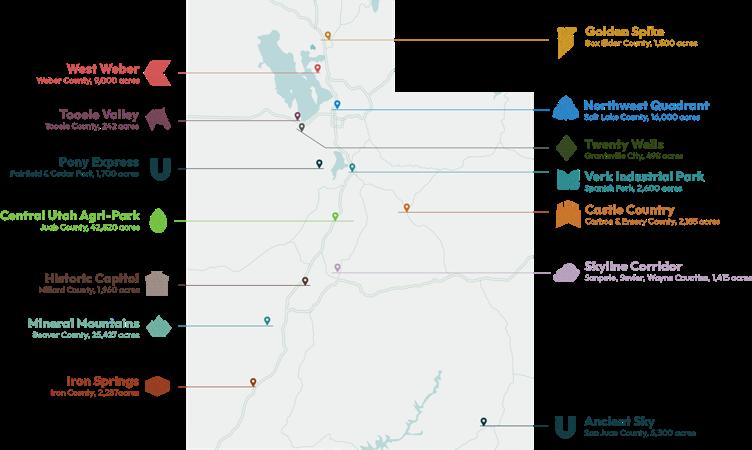
Utah is known as a strategic hub for transportation, but today, it's becoming a national model for next-generation logistics. At the heart of this transformation is the Utah Inland Port Authority (UIPA), which uses a network of project areas across the state to attract high-value businesses, streamline supply chains, and promote sustainable development.
“Utah is uniquely positioned to lead,” said Ben Hart, executive director of UIPA. “Our project areas are more than just industrial parks — they’re tailored ecosystems designed to give businesses the logistics infrastructure, workforce access, and multimodal connectivity they need to grow.”
From Cedar City to Box Elder County, UIPA’s project areas unlock local potential while linking businesses to global markets:
Golden Spike Project Area in Box Elder County is home to Lakeshore Learning’s 1.2-million-square-foot distribution center, bringing more than 500 jobs to rural northern Utah.
Iron Springs Project Area in Cedar City is Utah’s first Union Pacific Focus Site, offering direct rail access and shovel-ready land for advanced manufacturing.
Northwest Quadrant Project Area in Salt Lake City offers a rare combination of access to an international airport, intermodal rail terminal, and two major interstates — ideal for companies with time-sensitive shipping needs.
Twenty Wells Project Area in Tooele County supports long-term growth in clean industry and manufacturing while preserving critical wetlands nearby.
Each area is developed through close partnerships with local governments and industry leaders, offering location-specific advantages, infrastructure investment, and coordinated permitting processes.
Businesses located in a port project area gain more than proximity to logistics infrastructure — they also benefit from tax increment financing, performance-based incentives, and state-backed support for infrastructure development. These tools help lower upfront costs, accelerate timelines, and support long-term scalability.
UIPA’s statewide strategy focuses on building an efficient, reliable supply chain. From expanding air cargo routes through Salt Lake City International Airport to prioritizing rail over long-haul trucking, UIPA helps businesses move goods faster, cleaner, and cheaper.
“SLC International Airport is a major economic driver for the city and state,” said Bill Wyatt, board member of UIPA and executive director of the Salt Lake City Department of Airports. “As we focus on expanding our air cargo footprint, Utah will become more competitive in the global marketplace.”
UIPA stands out for its collaborative approach, bringing together cities, state leaders, and private industry to align infrastructure development with economic and community priorities.
“Our strength lies in partnership,” said Abby Osborne, UIPA board chair and Utah House of Representatives chief of staff. “By uniting public and private stakeholders, we’re building smart, strategic solutions that work for everyone, from rural communities to global companies. This level of coordination isn’t just helpful — it’s foundational to Utah’s economic future.”
UIPA isn’t just building connections for better transportation — it’s meaningfully connecting communities to opportunity, helping them expand in the way they need. Whether it’s rail access in rural counties or job creation near urban neighborhoods, UIPA plans for the future with local people and priorities in mind.
“Our job is to grow responsibly,” said Hart. “We’re not just building infrastructure — we’re building systems that benefit all Utahns, now and for generations to come.”
BY: UTAH INLAND PORT AUTHORITY
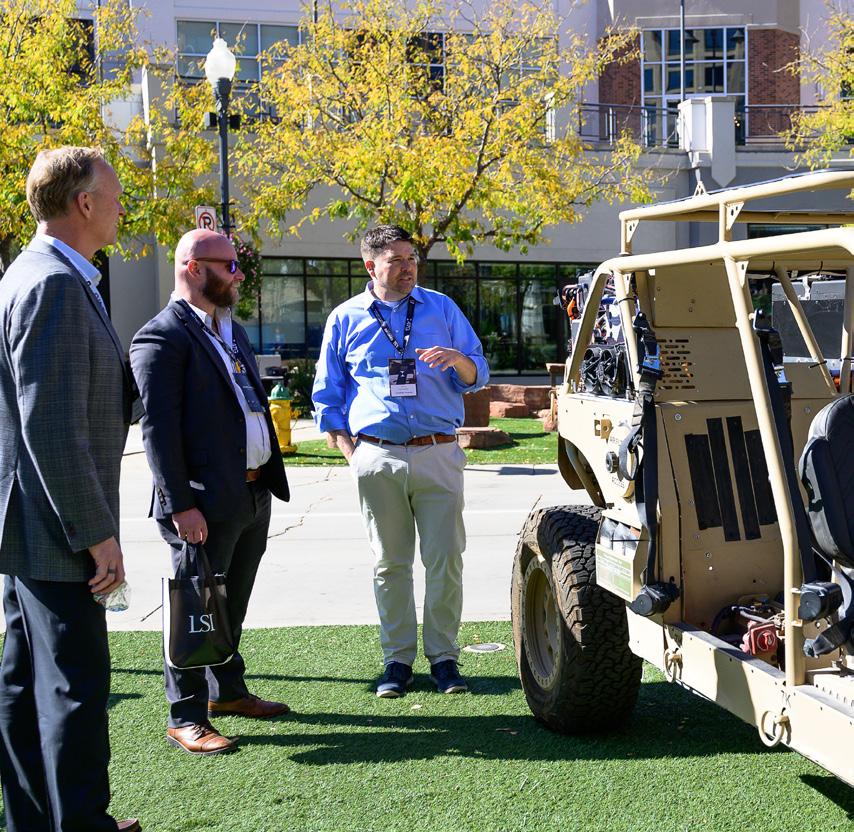
Utah is undergoing a bold transformation. Long celebrated for its stunning landscapes and outdoor adventure, the Beehive State is now emerging as a national leader in advanced manufacturing. With a deep legacy in traditional production, the state is embracing new technologies such as automation, artificial intelligence (AI), and robotics to stay competitive and future-ready.
Manufacturing remains a cornerstone of Utah’s economy, employing more than 155,000 Utahns, roughly 10.5% of the state’s workforce, and contributing 24.4% of Utah’s Gross Domestic Product (GDP). At a time when manufacturing has declined nationwide, our state stands out as a thriving hub of innovation.
Today, Utah’s manufacturing is defined by advanced production models integrating AI, robotics, and real-time data analytics. These advancements power the state’s diverse exports, which include primary metals, aerospace components, food and beverages, medical devices, and software-integrated electronics.
A Kem C. Gardner Policy Institute report highlights that Utah’s manufacturing jobs have rebounded faster than nearly any other sector. This growth is driven by innovation and deliberate strategies to lead in 21st century industries. Utah also ranks No. 4 nationally for Business Profile, a composite metric considering venture capital activity, foreign direct investment, and high proprietorship rates.
Utah’s diverse industrial base mirrors its diverse landscapes, helping create a resilient economy that weathers downturns and sustains steady job growth.
The state is a national leader in aerospace and defense, home to major contractors such as Northrop Grumman, Boeing, and L3Harris. At the same time, Utah has established itself as a powerhouse in bioscience and medical devices, producing everything from pharmaceuticals to advanced laboratory equipment.
Electronics and high-tech manufacturing are also rising, complementing the stability of long-standing sectors like food and beverage and primary metals. This combination of growth and stability ensures longevity for the state’s workforce and overall economy.
No industrial revolution is possible without a highly skilled workforce, and Utah consistently rises to the challenge. With strong STEM and CTE education programs, early access to technical certifications, and higher education institutions focused on workforce development, Utah is preparing its workforce for the future. The state’s six major universities — including the University of Utah, Utah State University,
Brigham Young University, Weber State University, Utah Valley University, and Utah Tech University — offer various advanced degree programs. Utah State University recently launched a Master of Science in Composite Materials and Structures to support advanced manufacturing needs.
Meanwhile, Utah’s network of community and technical colleges, such as Salt Lake Community College, Davis Technical College, and Mountainland Technical College, among others, delivers hands-on training in advanced composites, welding, automation, precision machining, and additive manufacturing.
Still, demand for talent continues to accelerate. To close this gap, Utah leverages public-private partnerships, such as Talent Ready Utah, to help workers transition into advanced manufacturing careers. The Utah Manufacturers Association is also leading innovative efforts, including apprenticeship programs and non-traditional pipelines like the Uniquely Abled Machinist Program, developed in partnership with the Columbus Community Center, which further grows the pipeline and finds options for young adults on the spectrum to succeed in skilled careers with growth opportunities.
Utah’s rise as a national leader in advanced manufacturing is no accident. It reflects deliberate investments, smart policy decisions, and strategic geography. At the crossroads of major western markets and home to key military and research assets, Utah offers businesses streamlined access to supply chains.
Low corporate taxes, pro-growth policies, and strong research incentives consistently place Utah among the most business-friendly states in the nation. More importantly, the state excels because of cross-sector collaboration, with government, education, and private industry working together to solve workforce challenges, expand R&D, and modernize manufacturing systems.
Utah is not simply participating in the next industrial revolution — it is leading it. By combining innovation, collaboration, and resilience, the state is building a manufacturing ecosystem designed for sustainable, hightech, and defense-integrated production for decades. The Beehive State is proving that advanced manufacturing is driving the future of its economy and America’s.
BY: UTAH MANUFACTURERS ASSOCIATION

There is no medical challenge that Utah’s life sciences industry is unwilling to tackle. Name a disease, and Utah likely has a company or researcher working on it.
The state is home to one of the fastest-growing life sciences hubs in the country. This growth is driven by over 1,600 companies that generate $22 billion in state GDP, create more than 180,000 jobs, and pay wages nearly 50% higher than the state average. The industry, which spans medical device manufacturing, laboratory testing, biotechnology, and biopharmaceuticals, has a core footprint in the Salt Lake City region, but extends north to Logan and south to St. George.
Life sciences are an essential contributor to Utah's economic engine. With 2.6% of its workforce employed in the industry, Utah ranks third among all states for life sciences employment concentration. In addition, Utah ranks eighth in the production of medical devices, exceeding states such as New Jersey, New York, Washington, and Illinois.
But there’s more to the story. Behind the state’s bio boom is a commitment to collaboration and community unique to Utah.
“Companies in Utah don’t see each other as competitors,” said David Bearss, CEO of Halia Therapeutics and a notable industry executive. “Instead, they compete against science and disease to ultimately improve and save patients’ lives.”
In that spirit, the industry thrives through a strong network of partnerships with state and local government, academic institutions, incubators, healthcare delivery networks, mentors, and trade associations such as BioUtah and BioHive.
Utah strongly supports the industry. The state Legislature has established a $40 million Utah Innovation Fund to provide seed funding for innovative technologies from Utah universities, including those in life sciences, helping these technologies become investment-ready. Utah has invested millions in growing and strengthening its workforce through internships, on-site placements, and hands-on training programs. Across the state, educators are nurturing discovery and training the next generation of life sciences professionals.
Utah’s favorable environment is attracting companies like Nusano, whose products will make the state the epicenter for radioisotope technology. Denali Therapeutics recently completed construction of a 60,000-square-foot manufacturing facility in Salt Lake City, the state's first biotech operation of its kind. Myriad Genetics, bioMérieux, Seek Labs, and Co-Diagnostics are among the many companies that provide products to diagnose disease. Meanwhile, Canyon Labs and Nelson Labs provide testing services for device and drug manufacturers to ensure quality.
ARUP Laboratories is a nationally and internationally recognized reference lab that continues to expand. The Sports Medicine Research and Testing Laboratory performs doping tests for the Olympics and other sporting events — one of just a few labs in the world qualified to do so.
In addition, large, established global companies like Becton Dickinson (BD), Edwards Lifesciences, Fresenius, Merit Medical Systems, Stryker Neurovascular, Teva Pharmaceuticals, Varex Imaging, GE HealthCare, Cytiva, Thermo Fisher, and Laborie have headquarters or significant operations in Utah.
Recursion, a company born out of the University of Utah, uses artificial intelligence and machine learning to speed drug discovery. Startups like DiscGenics, Renew Biotechnologies, and Curza are advancing answers to debilitating back pain, neurodegenerative disease detection, and antimicrobial resistance.
The efforts of Blackrock Neurotech and Biologic Input Output Systems (BIOS) are rapidly making Utah a leader in neurotechnology and brain-computer interface technology.
The industry’s passion for invention and innovation, culture of collaboration, and force for good has yielded a robust industry shaping the future of health and wellness worldwide.
BY: BIOUTAH AND BIOHIVE
Utah has transitioned into a more populous, mid-sized state with an elite economy. It is characterized by strong job growth, low unemployment, rising median household income, economic diversity, and more. The state’s economic prosperity, high quality of life, and outdoor and recreational amenities attract record numbers of new residents, boosting state and local economies. State leaders deploy prudent and efficient fiscal policies, ensuring long-term financial stability and fostering confidence in Utah as a worthy investment. Policymakers collaborate with private sector leaders to stimulate economic growth, improve services, and create social capital that benefits all Utahns.
uncertainty in the U.S. and worldwide will addpressure the state’s economic trajectory.
While the future is challenging, Utah remains favorably positioned to maintain growth and prosperity for future generations. Our state's true wealth extends far beyond its economic prosperity; it resides in the goodness, kindness, and generosity of its residents, our greatest asset.
In September 2025, the University of Utah’s Kem C. Gardner Policy Institute commemorated 10 years of societal impact and service to Utah. At the Gardner Institute, its research team works with gigabytes of data to provide data-driven, contextspecific insights that shed light and help Utah leaders make INFORMED DECISIONS™.
As we look ahead to the next 10 years of impact, our team is asking key questions of the data to build on and maintain Utah’s prosperity:
What makes Utah’s economy successful?
What are the challenges and risks facing Utah?
What public policies will maintain quality of life for all Utahns while managing future growth?
Like other states, Utah is not without economic challenges. Most notably, rapid population growth continues to drive a strong demand for housing, outpacing supply and leading to significant housing affordability constraints. Tight labor market conditions in certain industries could hamper future economic growth. Water scarcity, air quality, and other environmental concerns impair long-term development planning initiatives. Finally, as Utah’s national and international presence grows, economic and political
Utah has a unique way of coming together to meet the needs of our fellow Utahns. State and local leaders must invest in housing, infrastructure, healthcare, education, and more to help build upon our shared prosperity for future generations. They will need a trusted source for data-driven research to help guide their decision-making.
The Kem C. Gardner Policy Institute is the trusted broker of INFORMED RESEARCH, which guides INFORMED DISCUSSIONS, and leads to INFORMED DECISIONS™.
BY: KEM C. GARDNER POLICY INSTITUTE

Utah’s financial services industry is undergoing a digital transformation. With deep banking roots and a thriving tech ecosystem, the state has quickly become a national hub for financial technology, better known as fintech.
The state is home to over 50 banking institutions and 55 credit unions. As of 2024, Utah depository institutions combined total assets of just over $1 trillion. But it's not only traditional banking driving the growth. Companies like SoFi, MX Technologies, Lendio, HealthEquity, LoanPro, and Atomic Financial are leading a fintech wave, reshaping how Utahns manage, borrow, and invest their money.
Employment in Utah’s financial services sector has grown more than 10% over the past five years, supporting approximately 90,000 financial jobs statewide. This upward trend reflects job creation and evolving skill demands driven by the integration of advanced technologies.
Utah is a leader in fintech, integrating artificial intelligence, blockchain, and data analytics into financial systems to keep pace with a tech-savvy global workforce. Because of this and its entrepreneurial culture, the state is attracting new investment and fueling innovation across the industry.
Utah’s robust educational ecosystem supports that innovation. Twelve higher education institutions offer financial service-related programs, and Brigham Young University’s nationally recognized accounting and finance programs contribute to a steady pipeline of talent.
The Stena Center for Financial Technology at the University of Utah plays a pivotal role in advancing Utah’s fintech ecosystem. Backed by a $65 million endowment, it combines academic expertise with industry collaboration to drive innovation, support startups through its fintech studio, and prepare top-tier talent. By hosting key events and fostering public-private partnerships, it strengthens Utah’s position as a national leader in fintech.
Utah’s industrial banks also uniquely influence the national financial landscape. As of June 2024, the state’s 16 industrial banks held $206 billion in assets, representing nearly 100% of the national total.
The state’s favorable business climate adds to its appeal. The Tax Foundation ranked Utah No. 8 in the 2021 State Business Tax Climate Index, underscoring its competitiveness for startups and established firms.
As finance and technology increasingly intersect, Utah stands out as a place where innovation and industry are learning to thrive together. With next-generation lending platforms, personalized financial tools, and real-time data solutions, financial services are bright and poised to set a national example.
BY: ADELAIDE HAWKINS Marketing and Communications, GOEO
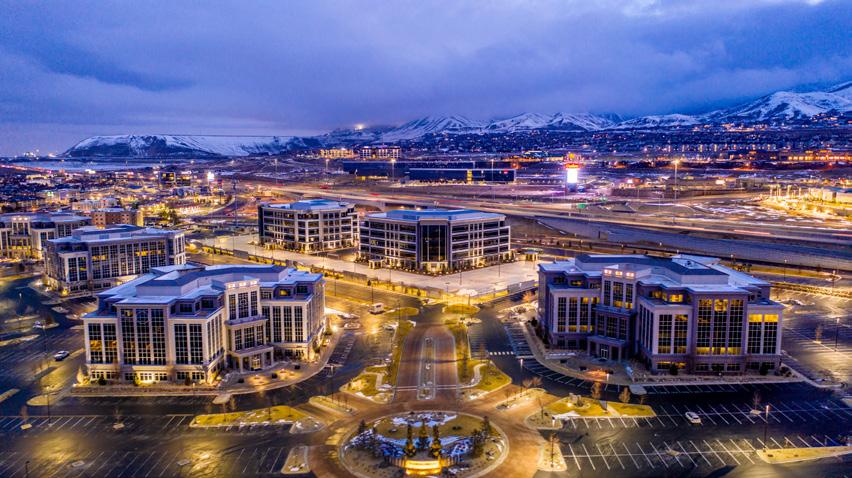

The Nucleus Institute is Utah’s bold new engine for driving innovation, collaboration, and commercialization statewide. This one-of-a-kind organization brings together higher education, industry, government, and capital to tackle Utah’s most pressing challenges and build the infrastructure for a dynamic and symbiotic innovation economy.
Nucleus is a hub for convergence. The institute strategically aligns sectors to accelerate the development of novel technologies and support emerging startups, with life sciences as one of its core focus sectors. The Nucleus Institute is a partner of the Utah System of Higher Education (USHE). Nucleus works in tandem with all 16 Utah institutions of higher education to support commercialization and workforce development.
Nucleus houses three cornerstone programs: Nucleus Grow, previously the Utah Innovation Center; the Nucleus Fund, previously the Utah Innovation Fund; and the Utah Policy Innovation Lab. Each program supports Utah’s long-term innovation strategy and fills critical gaps in the state's ecosystem.
Nucleus Grow transitioned from the Governor’s Office of Economic Opportunity to Nucleus in the summer of 2025. The Grow team remains Utah’s lead resource for accessing nondilutive federal funding, including SBIR/STTR grants. It is also an excellent resource for companies and researchers seeking alternative forms of funding. Nucleus Grow will maintain its team, services, and statewide impact, but is now bolstered by the institute’s expanded capacity and strategic partnerships.
The Nucleus Fund is the state’s $40 million pre-seed investment vehicle, addressing critical capital gaps for earlystage technologies. The fund invests in deep tech sectors such as life sciences, energy, aerospace, cybersecurity, and AI. To date, 70% of the fund’s investments have gone to life science-centric companies. The fund’s mandate for investment requires companies to have a significant tie to an institution of higher education in Utah. The unique model reflects a broader commitment by the state to ensure Utah’s most promising research translates into real-world solutions, market value, and job creation.
The Utah Policy Innovation Lab applies a research-driven approach to regulatory reform and policymaking, helping shape an environment where innovation can thrive. Its work ensures that entrepreneurs benefit from policies grounded in evidence, reducing barriers to entry and attracting innovative companies to Utah.
In addition to these cornerstone programs, Nucleus is focused on connecting students to industry through highimpact projects. It works with corporations to identify internal problems that need to be solved. A team of students is brought in to work in tandem with the company to create a solution. These high-impact projects provide real-world, indepth experiences for students that prepare them to thrive in the workforce of the future.
The Nucleus Institute will be headquartered in Convergence Hall, the centerpiece of Utah’s emerging Innovation District at The Point. This innovation campus will be a physical space where academia, government, and industry collaborate in new ways. Convergence Hall will fuel research and development, facilitate startup incubation, connect students to industry, and catalyze partnerships.
The launch of the institute marks a significant evolution in Utah’s innovation economy. It reflects the state’s vision to lead nationally in research commercialization, talent development, and inclusive economic growth. Utah lawmakers and business leaders are taking a proactive approach to building a future-ready innovation infrastructure that ensures equitable access to opportunity in every corner of the state. By unifying public and private resources under one agile entity, the institute blends the stability of public institutions with the speed of private enterprise.
Through coordinated investment, targeted programming, and an ecosystem-wide approach, The Nucleus Institute is poised to elevate Utah’s innovation capacity for decades. Learn more at nucleusinstitute.org.
BY: THE NUCLEUS INSTITUTE
"Collaboration across many industries and organizations is the key to successful corporate expansion and a resilient, robust economy. That’s why, in Utah, we build together."

Have you ever wondered what it takes to open a new business facility in another state — hundreds, and sometimes thousands, of miles away from your existing headquarters? Choosing to expand or relocate business operations can be a complex and lengthy process. Many partners are needed to support a company in considering Utah for a new business facility.
Before a company decides to relocate its operations or open a new facility, it needs to evaluate a community’s talent availability, real estate options, tax data, operating costs, state and municipal regulations, incentive programs, financing options, and more. The majority of corporate expansion and relocation projects that land in Utah have significant interactions with city, county, and state representatives; utility companies; and real estate brokers — just to name a few.
For example, Jeff Richards of CBRE Salt Lake City recently represented ACS Manufacturing during its search for an expansion site. Richards connected ACS Manufacturing to the Economic Development Corporation of Utah (EDCUtah), and the company’s decision to locate in Clearfield City resulted from collaboration among Clearfield City, Davis County, the Governor’s Office of Economic Opportunity (GOEO), EDCUtah, and the Northern Utah Economic Alliance. The company plans to create 223 new jobs and invest $34.1 million in Clearfield City over the next 10 years.
Once companies have decided to set up shop in Utah, they often seek support from local engineering and construction firms, electrical engineers, office design companies, staffing agencies, lawyers, financial institutions, and more.
Lakeshore Learning’s expansion in Garland City is a great example of the local support needed before and after the site selection decision. In August 2023, Lakeshore Learning announced plans to build a 1.2 million-square-foot distribution facility, creating 540 new, high-paying jobs and investing approximately $62 million in Box Elder County over the next 10 years. Throughout its expansion project, Lakeshore Learning has worked with Box Elder County, Garland City,
GOEO, EDCUtah, the Utah Inland Port Authority, CBRE, Millstream Partners, and ARCO Design/Build.
“Lakeshore’s 1.2 million square foot Garland distribution center represents a major milestone in job creation and economic growth for the region,” said Artin Ghazarian, chief supply chain officer for Lakeshore Learning. “This initiative is not just a collaboration, it is a partnership between Lakeshore and many local and state businesses and key leaders that showcases Utah’s commitment to innovation and community development.”
Companies that completed an expansion in Utah have a role to play in contributing to future corporate expansion projects. Last year, Fervo Energy broke ground on an enhanced geothermal energy production project in Beaver County. The Cape Station project is slated to produce 400 megawatts of power in the project's first two phases, and Phase I will begin delivering around-the-clock power to the grid in 2026. Fervo Energy is a potential partner for future companies as they begin generating power, which can be used to attract new development to Beaver County.
“We are very lucky to be building our first greenfield project in Beaver County, Utah,” said Sarah Jewett, vice president of strategy for Fervo Energy. “The community has been hugely welcoming and collaborative and has been an essential partner in the progress we’ve made to date.”
Collaboration across many industries and organizations is the key to successful corporate expansion and a resilient, robust economy. That’s why, in Utah, we build together.


